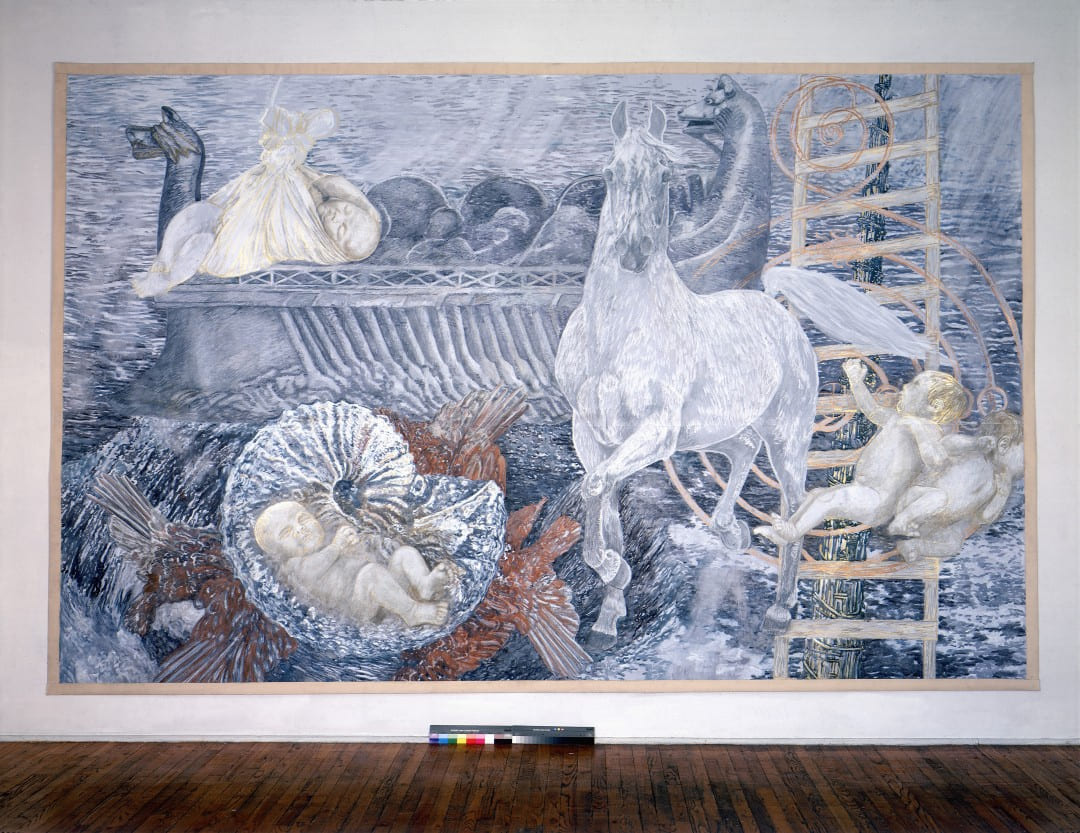
Courtesy of Ann McCoy
Contemporary artist Ann McCoy’s artistic inspiration comes from “dreams, mythology, alchemy and her spiritual practices,” as exemplified in works like “White Birth” from her 2001 “Mad Mother” series, where a light blue canvas of brush strokes and pencil marks depicts white babies on a floating sea.
McCoy was one of five Yale faculty awarded the prestigious Guggenheim Fellowship this year. The fellowship will provide her with resources to pursue a project that combines her roles as writer, projection designer, painter and sculptor. Currently, McCoy lectures on art history, mythology and projection in a Yale School of Drama class titled “Visual Storytelling.”
As a child growing up in the American Southwest, McCoy did not imagine a career as an artist. She lived near archaeologists, including Earl Morris, who reconstructed the Great Kiva at Aztec National Monument, and Joe Ben Wheat, who is known for his work in the Mesa Verde region. According to McCoy, Ben Wheat helped her with her science fair project on carbon-14 dating, which led her to an interest in archaeology. She then began helping at the archaeology museum at the University of Colorado.
“I thought I wanted to be an archaeologist and the art department was in the basement of the same building as the archeology department,” said McCoy. “One day, I picked up a piece of clay and started playing with it, and this voice inside my head just said, ‘you know, you’re supposed to be an artist.’ I didn’t know what an artist did or what an artist was, but I just somehow knew I would be an artist.”
McCoy graduated from high school two years early and went to the Kansas City Art Institute. She then studied sculpture, painting, philosophy and classics at the University of Colorado.
McCoy taught in the Barnard College art history department for twenty years. In addition to her role as professor, McCoy’s numerous art awards include the Prix de Rome, National Endowment for the Arts, the Berliner D.A.A.D. Kunstler Grant and the Pollock Krasner Foundation. Her work is included in many museum collections including the Metropolitan Museum of Art, the Museum of Modern Art, the Los Angeles County Museum of Art and Whitney Museum of American Art. Her work also featured in a past Venice Biennale exhibition titled “Art and Alchemy.”
Yet another of McCoy’s many hats is theatre projection design. McCoy began teaching at Yale after meeting Wendall Harrington, associate professor adjunct of design and head of the projection design concentration at the Yale School of Drama.
After her standardized projection exam, Harrington, who was her examiner, asked McCoy to lecture at the School of Drama for the Visual Storytelling class now co-taught by Harrington and McCoy.
“She had been dabbling around the art edges of projection design, but I did know that she taught art history, so I thought this would be a great person to bring in,” said Harrington. “I realized she had all of this background in mythology and spiritual symbolism, too.
Visual Storytelling is an interdisciplinary class created to amend the “lack of information in art history, visual history and background design” in Yale’s curriculum, Harrington said. She said the class remains one of the few YSD classes that is open to all Yale students regardless of school affiliation, a fact which ties into McCoy’s multifaceted background.
“I’ve never met a more honest, entertaining and open lecturer as Ann McCoy,” said Yale School of Drama Research Fellow in Projection Design Camilla Tassi DRA ’19. “She is unapologetic in her mission to promote dialogue, expression and social justice through art and its analysis.”
McCoy’s Guggenheim Fellowship project is inspired by the Colorado mines that formed the landscape of her childhood. Her father was a scientist who owned tungsten mines and shared his enthusiasm in the century-old Wolf Tongue Mill with McCoy. According to McCoy, The Glory Hole Mine in Central City Colorado proved especially inspiring. She described this formation as “like a honeycomb inside a mountain” and noted that “this idea of going into the earth fascinated me.”
“The wolf is a big symbol in alchemy,” McCoy said. “I’m interested in mining and refining of ores and how this relates to processes in the psyche, and our spiritual transformation – Alchemy was a symbolic language that dealt with the inner life, and was often linked to the ores.”
This year marks McCoy’s 39th time applying for the Guggenheim Fellowship. She says that after her initial success as an artist, spiritually-rooted art “had become taboo in the M.F.A. academic establishment stuck in critical theory and in the art world in general … It was very difficult to be an artist with my interests.”
“One of the problems with positivism, secularism and our materialistic and superficial society, is that people have forgotten about the life of the soul,” said McCoy. “We are seeing environmental destruction and mass addiction in our world so cut off from religious rituals celebrating agricultural renewal and nature.”
She noted that she draws inspiration from her childhood experiences of “seeing Pueblo and Apache rituals,” which she said had a “profound influence” on her art. She remembered how she “realized [that these rituals] were still grounded in rituals like the Hopi Snake Dance and Apache Maiden Ceremony that transversed the deepest layers of psyche and spirit.”
According to McCoy, the recent Guggenheim exhibition based on the work of Swedish mystic Hilma af Klint may have been what made her Guggenheim Fellowship possible. Its popularity, McCoy said, showed that “viewers were hungry for art linked to spirituality.”
“Doing away with the inner life as a spiritual path has caused us to lose our connection with nature and in many ways with ourselves,” said McCoy. Reflecting on af Klint’s exhibit and her Guggenheim Fellowship, she believes that the synthesis of spirituality and art is “coming back around.”
McCoy began teaching at Yale in 2010.
Phoebe Liu | phoebe.liu@yale.edu







